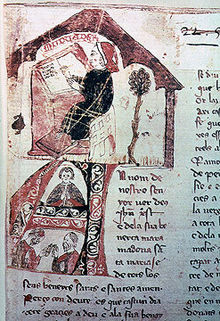
The Chronicle of Ramon Muntaner, written by the Catalan burgher and administrator Ramon Muntaner in Xirivella, Kingdom of Valencia, in 1325–1328, is the longest of what are known as "The Four Great Catalan Chronicles" of the 13th and 14th centuries. It narrates events relating to the history of the Crown of Aragon and to Muntaner's personal career in Iberia, Sicily, the Aegean and North Africa and spans the period from the conception of James I of Aragon in May 1207 to the coronation of Alfonso IV of Aragon in April 1328. Its character of "mirror of princes" and "mirror of citizens" has been pointed out by scholars.[citation needed]
The expedition of the Catalan Company to Byzantium in 1303, in which Muntaner took part as the treasurer of the company, forms the central episode of the chronicle, and likely provided the impulse for its composition.[1][2] It enabled the author to frame his own experiences within the larger context of Catalan-Aragonese affairs in the Mediterranean. In presenting his account, Muntaner relies on his authority of an eyewitness, as evidenced by his frequent use of "I was there".
The Chronicle survives in eight medieval copies, of which the oldest dated one is from 1342.[3] The first edition, which appeared in 1558, established the current subdivision of the work into 298 chapters and influenced the transmission of the text. Since the turn of the nineteenth century, the Chronicle has been the subject of studies by leading Catalan historians and philologists, among them Jaume Massó i Torrents, Lluís Nicolau d'Olwer, Josep Casacuberta, Ferran Soldevila and more recently Maria Teresa Ferrer i Mallol and Josep Antoni Aguilar Àvila, as well as by the Italian scholars Stefano Maria Cingolani and Veronica Orazi.
- ^ Keightley 1979, p. 37–43, 51–53.
- ^ Cingolani 2007, p. 159–193.
- ^ Aguilar Àvila 2015, p. 271.